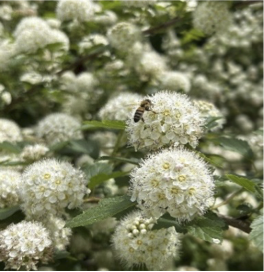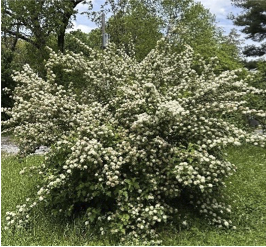News Archives » Director
Choosing Native Shrubs for Pollinator Gardens May 9th, 2024
By Sr. Maxine Pohlman, SSND, Director, La Vista Ecological Learning Center
La Vista’s pollinator garden at the Immaculate Heart of Mary Novitiate in Godfrey, IL, is taking on a new look this season. At the wise advice of our master gardener, we’ve introduced native shrubs which are often. overlooked when planning a garden to serve pollinators.
Benefits
– One mature shrub, like the buttonbush pictured here, can provide more nectar and pollen than a single perennial plant. This bush just hummed with bees and butterflies in April and May!
– Some flowering shrubs bloom early in the season, providing food before other native flowers; for example, outside the office at La Vista, spicebush bloomed while it was still quite cool. Native bees abounded on the small yellow flowers before I observed them anywhere else.
– Native deciduous shrubs often offer seasonal interest; for example, in addition to flowers in spring and summer, they may provide fruit, nuts, seedpods, or berries, like these developing on the spicebush pictured here. In late summer they turn red, attracting wildlife.
– Many native plants are larval hosts for butterflies and moths.
– Once established, most shrubs will not need watering!
– No need for fertilizers, pesticides or herbicides on these natives!
What Are Native Species?
Native species are those that evolved in an area along with animal life, unlike naturalized species introduced by humans, such as those brought by Europeans when they colonized this country as well as those sold by nurseries because they have some special appeal for the unaware gardener. Many nurseries now have a special “native plant” section.
Natives we planted include: nannyberry viburnum, fragrant sumac, buttonbush, black chokeberry, black elderberry, spice bush, arrowwood viburnum and witch hazel. All are doing well in their second year.
 (Native bee on bloom) |
A New Garden Ethic
Since development and agriculture have eliminated much pollinator habitat, since we have used pesticides so prolifically for so long, and since the climate and biodiversity crises are upon us, it has become our responsibility to plan a garden not only pleasing to the human eye, but also beneficial for pollinators including bees, butterflies, moths, bats, birds, wasps, flies.
To read more about this, get Benjamin Vogt’s book A New Garden Ethic. Let this quote entice you:

“Simply put, environmentalism is not political; it’s social justice for all species marginalized today and for those facing extinction tomorrow.
By thinking deeply and honestly about our built landscapes, we can create a compassionate activism that connects us more profoundly to nature and to one another”.




